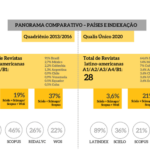By Lilian Nassi-Calò

Photo: Tax Credits.
The communication of academic research results in refereed journals has undergone significant transformation with the advent of the Internet. The dominant business model of print publications – where readers pay to have access to articles – started to share space with electronic journals and new forms of access. The high costs of journal subscriptions boosted the open access movement (AA) started in the 90s, and the emergence of online publications free from access barriers and most copyright barriers that existed previously.
The SciELO program, launched in 1998, pioneered the adoption of open access even before the consolidation of this form of publication through the OA movement. As a result, Latin America has become the region with the highest number of peer reviewed journals available in full text. Later on Portugal, Spain and South Africa joined the collection. Today SciELO has over one thousand journals and 500,000 articles, forming one of the largest open access initiatives in the world.
Studies in 20141 estimated that 35-50% of published articles are available in OA, with increasing trend. Since the readers are free to access the articles, the bill falls on: the institution or scientific society responsible for journal, sponsoring advertisers, private or public supporters, or the authors (and their institutions), by collection of publication fees called article processing charge (APC). There is yet a third way, the hybrid journals, in which the authors who choose to provide their articles in OA pay the APC, while the other articles remain accessible on individual payment or journal subscription.
In the last decade, there was a large increase in OA journals that use APC, and many of them enjoy high reputation in their fields, such as the BioMed Central collection, which brings together more than 360 quality peer reviewed journals in biomedicine, and the SciELO program, with over one thousand journals in all areas of knowledge. The BioMed Central operates with different APC values, however, absolve from payment authors from low-income countries. At SciELO, a small part of journals work with APC only to cover publication costs, since the vast majority of publishers is not for profit. New forms of peer review have also emerged, such mega-journals like the PLoS collection, that appraise scientific rigor and validity, but leave to the readers to assess the relevance of the results. This new peer review approach has also been adopted by other OA journals.
The popularization of open access journals that advocated expeditious publication and use the facility of web platforms has given rise to a class of journals that do not perform formal peer review and aims solely to collect APC from those who want to quickly inflate their publications list. This class of journals was given the name ‘pseudo journals’ and to their publishers ‘predatory publishers’.
The dilemma of predatory publishers was illustrated by a study conducted at two universities in Nigeria2, in which respondent scholars revealed the difficulty of publishing in ‘Western’ journals at the same time they were required to publish in international journals. This may have driven the emergence of predatory journals in Africa and also in other countries such as Pakistan, China and India.
Predatory publishers cause immense damage to the image of OA journals that charge APC, mainly due to sensationalist articles published in the scientific literature alleging that OA is synonymous with low quality publications, debatable methodology and lack of peer review. Consequently, many authors are reluctant to submit their articles to OA journals, which hamper their inclusion in renowned international databases such as Web of Science.
So far there was no detailed analysis on predatory publishers worldwide and their characteristics, to the recent article in BMC Medicine authored by Ceny Shen and Bo-Christer Björk from the Hanken School of Economics, Helsinki, Finland3. The authors conducted a comprehensive study which identified 1,030 publishers (614 of the Jeffrey Beall’s predatory journal list4 and 416 individual publishers). The authors, however, emphasized that the use of Beall’s list found only practical justification, because it is a highly controversial source.
On preliminary examination remained 966 publishers and 11,873 journals. Of this total, the authors drew a representative sample of 656 publishers and 613 journals. This sample was analyzed for the country declared by the publishers, number of journals published, number of articles per year in each journal, authors’ country of affiliation and values of APC charged.
The total number of journals published by predatory publishers increased from 1,800 in 2010 to 8,000 in 2014. These journals overall published 53,000 articles in 2010 and nearly ten times more, 420,000 articles in 2014. From 2012 to 2014 publishers editing between 10-99 journals registered the largest increase in number of published articles. Those who publish between 2-9 journals and publishers of one single journal showed less pronounced, but steady, increase between 2010 and 2014.
As for the journal field of knowledge, those categorized as nonspecific published the bulk of articles in 2014. Then come engineering (97,000 articles) and biomedicine (70,000 articles) journals. The mean number of articles per year in the sample rose from 30 in 2010 to 53 in 2014.
The country declared by the publishers is a controversial matter. Some inform addresses in the US or Western Europe, but these are often non-existent or only a P.O. box. On the selected sample (656 publishers), 27% are located in India, 11.6% in Asia, 5.5% in Africa, 8.8% in Europe and 17.5% in North America. From a large part (26.8%) it was impossible to determine the country of origin. There is still 1.7% in Australia, 0.5% in South America and 0.5% in the Middle East.
To assess the country of affiliation of the authors and the average time of publication, a smaller sample was used. Forty seven journals that indicated submission and approval dates were identified and 5 random articles of each journal were taken. In this sample, 34.7% of the authors are from India; 25.6% from Asia; 16.4% from Africa; 9.2% from North America; 8.8% from Europe; 2.3% from South America; 1.5% from Australia and 1.5% undetermined. As for the average time of publication, we obtained 3.6 months between submission and publication, and a median of 2.7 months.
The APC values vary greatly between large and small publishers. The average values for each stratum according to the number of published journals show that small publishers (one journal, 2-9 and 10-99 journal publishers) operate with APCs ranging US$ 83-133, while for over 100 journal publishers this figure raises to US$ 796. The authors estimate, based on these data, that the predatory publishers market mobilized US$ 74 million in 2014. Reputable OA journals, however, mobilized in 2013 US$ 244 million. For comparison, the subscription journal market mobilized that year US$ 10.5 billion. Posts previously published in this blog5,6 indicate that the transition from the subscription model to APC funded OA is totally feasible. Some factors, however, hinder its progress.
The relatively low APC value charged by most predatory publishers makes sense considering that 39% of the authors from emerging countries are personally responsible for paying the fee, versus 10% of authors from developed countries. This is in accordance with the highest growth of small predatory publishers reported in the study. The position of Shen and Björk7 as the author’s knowledge on the predatory nature of the journals is quite interesting. According to them, the authors are not innocent victims and make a conscious decision to take the risk of publishing in these journals, probably hoping that a cursory review of his publications list would not expose them immediately. Again, valuing quantity over quality distorts the evaluation of research and perpetuates practices of this nature.
Noteworthy is the observation about the low percentage of predatory publishers (0.5%) and authors (2.2%) from Latin America (LA) in this study. Shen and Björk attribute this to a combination of factors where the region’s infrastructure is different from other developing regions. Scientific communication in the LA region relies on a collection of quality peer reviewed open access journals through the SciELO program. The program is mainly characterized by non-profit publishers that usually publish a single journal or a few, that usually rely on public funding through research institutions or scientific societies. Few operate with APC enough to cover publication costs and 25% of these journals are indexed in Web of Science.
The authors conclude the work with a relevant remark: “Important reputable OA publishers have not stood by silently as OA has been given a bad name by predators. Rather than blacklisting journals, which Jeffrey Beall is doing, the strategy has been one of defining quality criteria and accreditation of journals that meet those” stated Shen and Björk, citing initiatives such as DOAJ and the Open Access Scholarly Publishing Associations (OASPA), who work to improve the quality and credibility of open access publications. “An increased share of respectable OA journals is also nowadays indexed by the WoS.”
Notes
1. SPINAK, E. Open access articles are here to stay: in less than 10 years nearly 50% of articles worldwide can be accessed this way. SciELO in Perspective. [viewed03 October 2015]. Available from: http://blog.scielo.org/en/2013/08/28/open-access-articles-are-here-to-stay-in-less-than-10-years-nearly-50-of-articles-worldwide-can-be-accessed-this-way/
2. OMOBOWALE, A. O.; et al. Peripheral scholarship and the context of foreign paid publishing in Nigeria. Current Sociol. 2014, vol. 62, nº 5, pp. 666–684. DOI: 10.1177/0011392113508127
3. SHEN, C and BJÖRK, B. C. Predatory open access: a longitudinal study of article volumes and market characteristics. BMC Medicine. 2015, vol. 13, nº 1, pp. 230-245. DOI: 10.1186/s12916-015-0469-2
4. BEALL, J. List of publishers. Scholarly Open Access. 2015. Available from: http://scholarlyoa.com/publishers/
5. COP, N. Can monies spent globally on journal subscriptions be completely transitioned to an OA business model to free the journals?. SciELO in Perspective. [viewed 08 September 2015]. Available from: http://blog.scielo.org/en/2015/05/26/can-monies-spent-globally-on-journal-subscriptions-be-completely-transitioned-to-an-oa-business-model-to-free-the-journals/
6. VELTEROP, J. What is holding back the transition to open access if it does not cost more?. SciELO in Perspective. [viewed03 October 2015]. Available from: http://blog.scielo.org/en/2015/09/10/what-is-holding-back-the-transition-to-open-access-if-it-does-not-cost-more/
7. REGO, T. C. Productivism, research and scholarly communication: between poison and medicine. Educação e Pesquisa. 2014, vol. 40, nº 2, pp. 325-346. DOI: 10.1590/S1517-97022014061843 Available from: http://ref.scielo.org/t6pjw8
References
BEALL, J. List of publishers. Scholarly Open Access. 2015. Available from: http://scholarlyoa.com/publishers/
BEALL, J. Predatory publishers are corrupting open access. Nature. 2012, vol. 489, nº 7415, p. 179. DOI: 10.1038/489179a
COP, N. Can monies spent globally on journal subscriptions be completely transitioned to an OA business model to free the journals?. SciELO in Perspective. [viewed 08 September 2015]. Available from: http://blog.scielo.org/en/2015/05/26/can-monies-spent-globally-on-journal-subscriptions-be-completely-transitioned-to-an-oa-business-model-to-free-the-journals/
FAUSTO, S. The Evolution of Open Access: a brief history. SciELO in Perspective. [viewed 03 October 2015]. Available from: http://blog.scielo.org/en/2013/10/21/the-evolution-of-open-access-a-brief-history/
MCGLYNN, T. The evolution of pseudojournals. Small Pond Science. Dominguez Hills, CA. 2013. Available from: http://smallpondscience.com/2013/02/14/the-evolution-of-pseudojournals/
MOMEN, H. Jeffrey Beall and Blacklists. SciELO in Perspective. [viewed 03 October 2015]. Available from: http://blog.scielo.org/en/2015/08/04/jeffrey-beall-and-blacklists/
OMOBOWALE, A. O.; et al. Peripheral scholarship and the context of foreign paid publishing in Nigeria. Current Sociol. 2014, vol. 62, nº 5, pp. 666–684. DOI: 10.1177/0011392113508127
PATTERSON, M. Meeting considers how open access could address inequalities – Originally published in Research Information on October 19, 2014. SciELO in Perspective. [viewed 03 October 2015]. Available from: http://blog.scielo.org/en/2014/10/19/meeting-considers-how-open-access-could-address-inequalities/
REGO, T. C. Productivism, research and scholarly communication: between poison and medicine. Educação e Pesquisa. 2014, vol. 40, nº 2, pp. 325-346. DOI: 10.1590/S1517-97022014061843 Available from: http://ref.scielo.org/t6pjw8
SCIENTIFIC ELECTRONIC LIBRARY ONLINE. Controversial Article in The Journal “Science” exposes the weaknesses of Peer-Review in a set of Open Access Journals. SciELO in Perspective. [viewed 03 October 2015]. Available from: http://blog.scielo.org/en/2013/11/05/controversial-article-in-the-journal-science-exposes-the-weaknesses-of-peer-review-in-a-set-of-open-access-journals/
SHEN, C and BJÖRK, B. C. Predatory open access: a longitudinal study of article volumes and market characteristics. BMC Medicine. 2015, vol. 13, nº 1, pp. 230-245. DOI: 10.1186/s12916-015-0469-2
SPINAK, E. Open access articles are here to stay: in less than 10 years nearly 50% of articles worldwide can be accessed this way. SciELO in Perspective. [viewed 03 October 2015]. Available from: http://blog.scielo.org/en/2013/08/28/open-access-articles-are-here-to-stay-in-less-than-10-years-nearly-50-of-articles-worldwide-can-be-accessed-this-way/
VELTEROP, J. The fenced-off ‘nice’ publication neighbourhoods of Jeffrey Beall. SciELO in Perspective. [viewed 03 October 2015]. Available from: http://blog.scielo.org/en/2015/08/01/the-fenced-off-nice-publication-neighbourhoods-of-jeffrey-beall/
VELTEROP, J. What is holding back the transition to open access if it does not cost more?. SciELO in Perspective. [viewed 03 October 2015]. Available from: http://blog.scielo.org/en/2015/09/10/what-is-holding-back-the-transition-to-open-access-if-it-does-not-cost-more/
External links
BioMed Central – <http://www.biomedcentral.com/>
DOAJ – <http://doaj.org/>
PLoS – <http://www.plos.org/>
 About Lilian Nassi-Calò
About Lilian Nassi-Calò
Lilian Nassi-Calò studied chemistry at Instituto de Química – USP, holds a doctorate in Biochemistry by the same institution and a post-doctorate as an Alexander von Humboldt fellow in Wuerzburg, Germany. After her studies, she was a professor and researcher at IQ-USP. She also worked as an industrial chemist and presently she is Coordinator of Scientific Communication at BIREME/PAHO/WHO and a collaborator of SciELO.
Translated from the original in portuguese by Lilian Nassi-Calò.
Como citar este post [ISO 690/2010]:

















Pingback: Open Access in Latin America free of predatory journals | Veille juridique